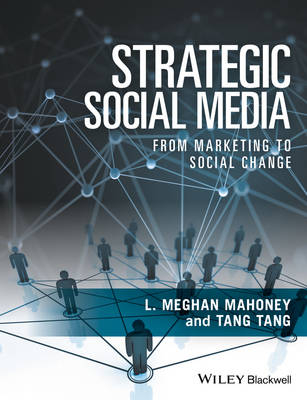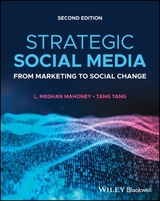
Strategic Social Media
Wiley-Blackwell (Verlag)
978-1-119-25919-0 (ISBN)
- Titel erscheint in neuer Auflage
- Artikel merken
Explores the best marketing practices for reaching business goals, while also providing strategies that students/readers can apply to any past, present or future social media platform
Provides comprehensive treatment of social media in five distinct sections: landscape, messages, marketing and business models, social change, and the future
Emphasizes social responsibility and ethics, and how this relates to capitalizing on market share
Highlights marketing strategies grounded in research that explains how practitioners can influence audience behaviour
Each chapter introduces theory, practice, action plans, and case studies to teach students the power and positive possibilities that social media hold
L. Meghan Mahoney is Associate Professor in the Department of Communication Studies at West Chester University of Pennsylvania. She regularly publishes research on issues related to new media audiences, social media, and marketing messages for behaviour and social change, most recently in the Journal of Media Education, Journal of Intercultural Communication, Journal of Medical Internet Research, Journal of Development Communication, and theJournal of Media and Communication Studies. She currently serves as Chair of the Management, Marketing & Programming Division of the Broadcast Education Association, and Social Media Coordinator for the Eastern Communication Association. Tang Tang is Associate Professor and Director of Graduate Studies in the School of Communication at The University of Akron. She has published articles in the Journal of Broadcasting & Electronic Media, International Journal on Media Management, Mass Communication & Society, Journalism & Mass Communication Educator, and Journal of Sports Media. She is a Faculty Fellow of the National Association of Television Program Executives, and has held leadership positions in the Broadcast Education Association and the International Communication Association.
Introduction 1
Reference 3
Part 1 Social Media in Convergence
1 Understanding Social Media and Social Behavior Change 7
Introduction 7
Bridging Communication Theories and Social Media Practitioners 10
Linear Communication Models to Modern Transactional Processes 10
Marketing and Behavior Change Theory 13
Summary 20
References 21
2 Information Diffusion 23
Introduction 23
Diffusing Your Message 24
Web 1.0 to 2.0 Technology Structure 26
Transparency, Control and Public Relations 29
Summary 40
References 41
3 Establishing Community 44
Introduction 44
Community Development Theory 45
Behavior Change and the Power of Social Networks 50
Brand Authenticity 52
Summary 57
References 59
4 Mobilizing Your Audience 61
Introduction 61
Social Media Mobilization 62
The Power of User-Generated Content 65
Offline Advocacy 68
Summary 74
References 75
Part 2 Social Media Users and messages
5 Transforming Audiences into Users 81
Introduction 81
Transforming Passive Audiences to Empowered Users 82
Predicting Social Media Use and Audience Behavior 86
Social Media User Profile 90
Summary 94
References 96
6 Active Within Structures 99
Introduction 99
Theory of Active Within Structures 100
The Role of Structure 103
Recognizing Constrained Active Choices 107
Summary 112
References 113
7 Best Practices for Social Media Engagement 115
Introduction 115
The Theory of Dialogic Communication 116
Online Engagement and Virtual Communities 118
The Dialogic Loop 123
Summary 127
References 128
8 Mobile Marketing and Location-based Applications 130
Introduction 130
Mobile Digital Projections 132
Peer Influence and a Shared Social Journey 135
Generating Return Visits 137
Summary 140
References 142
Part 3 Social Media Marketing and Business Models
9 Reconsidering the Long Tail 147
Introduction 147
Power-Law Distribution 148
Theory of the Long Tail 149
Inbound Marketing 152
Summary 158
References 159
10 Social Media Business Models 161
Introduction 161
Developing a Business Model 162
The Return on Investment of Social Media 167
One Business Model Doesn’t Fit All 172
Summary 175
References 176
11 Social Media Marketing Strategies 180
Introduction 180
Transitioning from Traditional Marketing 181
Applied Strategic Theory 183
Branded Social Experience 189
Summary 193
References 194
12 Evaluating Social Media Marketing 196
Introduction 196
Current Social Media Marketing Measurements 197
Building on the Focus Group 200
Audience Reception Approach 201
Summary 206
References 208
Part 4 Marketing for Social Good
13 Social Media and Health Campaigns 213
Introduction 213
Activation Theory of Information Exposure 215
Health Belief Model 218
Mobile Reach 222
Summary 226
References 227
14 Social Media and Civic Engagement 230
Introduction 230
Historical Shifts of Civic Engagement 232
Civic Engagement and the Individual Self 235
Technology and Political Communication 238
Summary 243
References 244
15 Communication for Development 247
Introduction 247
Introduction to Communication for Development 248
Modernization, Dependency and Participatory Approaches to Behavior Change 250
Opportunities and Challenges of Communication for Development Approaches 254
Summary 260
References 261
16 Social Media and Entertainment-Education 264
Introduction 264
Theoretical Underpinnings of Entertainment-Education 266
Entertainment-Education and Public Health 268
MARCH Model of Behavior Change 269
Summary 276
References 277
Part 5 Social Media for Social and Behavior Change
17 Integrating Old with New 281
Introduction 281
The Culture of Convergence 282
Remediation Theory 286
Integrating Social Media in a Post-Convergence Era 287
Summary 292
References 294
18 Social Media for Social Behavior Change 297
Introduction 297
We First 298
Role of the User 301
Identification through Social Behavior 304
Summary 308
References 310
19 Arguing for a General Framework for Social Media Scholarship 312
Introduction 312
The Six Paradigms of Communication Theory 313
A General Framework for Mass Media Scholarship 318
Key Intersections of Social Media Scholarship 320
Summary 323
References 324
20 The Future of Social Media 326
Introduction 326
The Future Social Media Landscape 327
Web 3.0: Asynchronous Mass Delivery 331
Conclusions and Recommendations 332
Summary 337
References 339
Index 343
| Erscheinungsdatum | 08.11.2016 |
|---|---|
| Verlagsort | Hoboken |
| Sprache | englisch |
| Maße | 188 x 249 mm |
| Gewicht | 771 g |
| Themenwelt | Wirtschaft ► Betriebswirtschaft / Management ► Marketing / Vertrieb |
| ISBN-10 | 1-119-25919-3 / 1119259193 |
| ISBN-13 | 978-1-119-25919-0 / 9781119259190 |
| Zustand | Neuware |
| Informationen gemäß Produktsicherheitsverordnung (GPSR) | |
| Haben Sie eine Frage zum Produkt? |
aus dem Bereich



